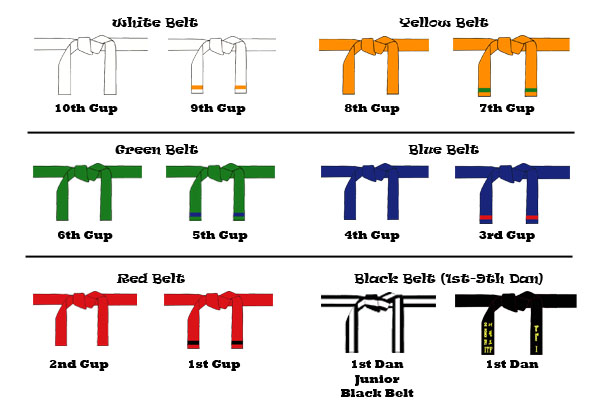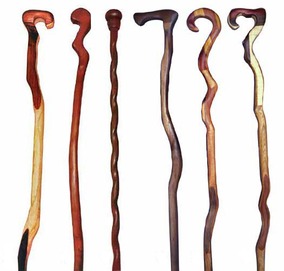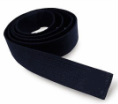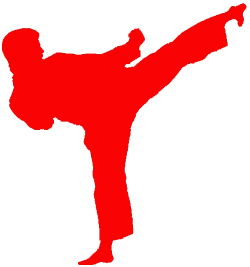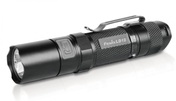A Guide to the Taekwondo Belt System If you're thinking of taking Taekwondo lessons, one of the first things you should know is you're going to get a lot of belts.
Belts don't make you a better fighter. They won't make you love martial arts any more or less, and you certainly don't need them to hold your pants up because most uniforms come with an elastic waist and drawstrings. The benefit to a belt system has nothing to do with utility and everything to do with mindset. They're essential to help you focus during what is often repetitive and rigorous training. Keep Your Eye On The Prize Belts are goals practitioners set and then work hard to achieve. Each level pushes the martial artist harder both mentally and physically, and by the time you've reached the higher belts you're stronger, more disciplined, and in the best shape of your life. Studying martial arts takes patience and time, and Taekwondo is no exception. Earning a black belt doesn't happen over night. It can take anywhere from 3-6 years, depending on the quality and philosophy of the Dojang. Whether they rush you through or actually make you learn the stuff, earning a black belt is a commitment and it helps to have some brightly colored goals to help you stay on the path. Junior Levels The junior level has 10 ranks (gup) that are referred to as the "color belts." Typically students start out at tenth gup (or white belt) and work their way to first gup (often a red belt with two black stripes but sometimes a black and red striped belt). The range of colors differ for each Dojang. The traditional belt colors are white, yellow, green, blue, and red, with each belt requiring two stripes before advancing to the next color level. Some Dojangs offer additional colors to keep their students moving (and to keep testing fees rolling in). In addition to traditional colors, the orange, purple, and brown belts might also be required before students are eligible for senior levels. The additional colors don't extend the training period. It just requires practitioners to test more frequently. Senior Levels The senior level has nine ranks (dan) that are referred to as the black belts or degrees. Before earning a first-degree black belt (or first dan), practitioners under the age of 15 must first become a junior black belt. In many Dojangs all practitioners must achieve junior black belt status before advancing regardless of their age. Junior black belts are red and black striped belts. Once you've earned the junior black belt, you then have to wait anywhere from 4-6 months before becoming a full black belt. Testing To move up a belt level in Taekwondo you have to complete a series of tests, each one building on the other. Tests require you to master a variety of kicking and basic exercises, as well as the more complex form sets. There's also a board breaking requirement, and in certain Dojang's a boxing element. The amount of time between tests in the junior level is minimal compared to the senior level. At junior level, depending on your gup, you'll have to wait anywhere from 1-4 months between tests. At senior level the time that must pass between each test increases greatly. Practitioners at the senior level can be waiting anywhere from 1-2 or more years between tests. The Sign of Hard Work Working your way through the Taekwondo belt system takes patience and endurance. It helps to have goals which is why belts are needed. It's not a perfect system and some Dojangs abuse it, but overall belts are a good idea to keep you focused. Plus, once you've advanced, you can get a display and hang your old belts on the wall. Just as it's important to set and work towards goals, it's equally important to sit back from time to time and admire the fruits of your labor. Never underestimate the power of a good old-fashioned stick when it comes to weapon selection in self-defense situations. Stick-like objects are readily available, be it brooms, pool cues, fallen timber, or a variety of other household-type objects.
Pros and Cons Short sticks are easier to handle, but require more up-close interaction. Long sticks can allow some distance from your attacker but can easily break and can be difficult to control. Tip: Broom handles and the like can easily be broken. Two sticks are often better than one. When people think of boxing most conjure images of a heavily-lit ring with two opponents dancing around one another throwing punches until a bell dings and calls them back to their respective corners. Although roped rings and title fights are part of one type of boxing style, there are many other forms the average person can use to help get them in shape quickly and to give them the skills they need to defend themselves in the real world. American, Thai and Filipino-style boxing are three forms that give you an increased cardio workout all while training you to defend yourself. American-Style Boxing American-style boxing is an excellent way to build your core strength and to increase your cardio workout. American-style boxing works out your upper body and tightens your core by giving you a variety of punching combinations to choose from. Jabs, crosses, hooks, and uppercuts are all styles of punches American-style boxers use, each one posing a specific threat to the opponent. Jabs and hooks can be used to stun or to offer a distraction from crosses and uppercuts, the power punches. Although kicks aren't used in American-style boxing, feet are still important. Stances and body movement are critical areas of focus, and when done properly make you a more effective boxer and give you a better workout. The strength in using American-style boxing as part of your workout is the cardio component. After two minutes of hitting the bag vigorously your arms will feel like Jell-O and you'll be standing in a pool of sweat, winded and exhilarated. American-style Boxing: "The Long Drill" Thai Boxing (Kickboxing) Thai boxing, also known as muay thai, is the national sport of Thailand and can be traced back thousands of years. It was originally created by soldiers who had lost their weapons in battle as a last stand tactic. Muay thai uses stand-up striking techniques where opponents traditionally exchange blows, specifically kicks, until one wins out. The blow-for-blow foundation of muay thai has evolved to include using the entire body. Today muay thai incorporates knees, elbows, and punching, but kicking is still very much a part of the foundation. A Thai kick is different than the kicks used in other martial arts forms like Taekwondo. In Taekwondo the kicks are snapped out with speed and are often used as a stunning technique to allow for more fatal strikes. Thai kicking, on the other hand, is about brunt force and requires an enormous amount of core strength because the hips must be rotated more aggressively than they are when using stunning kicks. The kicking is what makes muay thai an excellent form of boxing for strengthening your core and tightening leg, and more importantly, ass muscles. Muay Thai - "Long Drill" Filipino Boxing Panantukan is the boxing component of Filipino martial arts. Since an organization hasn't adapted its forms for safety and conformance, Panantukan has the reputation for being a "dirty street fighting" method. Frequent targets in Panantukan are biceps, triceps, eyes, nose, throat, jaws, temples, groin, ribs, spine, and the back of the neck. The idea in Panantukan is to take out the vitals: vision, air and sound. Once an opponent can't see, breath or hear, they're virtually defenseless. The main benefit to practicing Panantukan is the self-defense skills you acquire. Although the physical workout is fairly strenuous, the mental workout is tougher. In Panatukan your strikes are quick and pointed, and your defense is purposeful and aggressive. The sequence of combinations, when practiced with a partner, can get your heart rate pumping, but it's the mental challenge of knowing what combo to use in which situation that's the true workout. Filipino Boxing - "Counter Series" Give boxing a go.
You don't need a lot of money to box. Shadow boxing is free, and if you focus on your form, breathing, and foot movement while in front of the mirror, you'll find your muscles will quickly start burning and you'll get your heart rate up. If you want a more focused workout, punching bags are reasonably priced at retail stores or you can make your own with sand and an old army duffel bag. Either way a punching bag can be supported by most stud beams and can be easily stored in a closet when not in use. If you don't want to invest in buying equipment but still want to sprinkle some boxing into your workout routine, most traditional fitness gyms have at least one punching bag, and many offer specialized classes in boxing and kickboxing. If you want to go in whole hog, most major cities have specialized boxing gyms because doing boxing as a workout is a growing trend. The prices for membership at boxing gyms vary, but some can get quite expense depending on the location and available services and hours. Martial arts-style boxing classes are a little harder to come by. You might want to start at your local martial arts center to see what's available in your community. Whether you sign up at a gym, shadowbox, or hang a bag in your garage or spare room, boxing in any form is an excellent way to build core strength and give you practical self-defense skills, if ever the need arises. Boxing builds muscle tone, endurance, speed, strength, and power. Give it one month, and you'll find it's a fun, effective, and invigorating exercise that produces results. Plus, it's a great way to relieve stress. Practicing martial arts provides many benefits. It gives you valuable self-defense skills and, at the same time, is a graceful and moving art form. Although these benefits are nice, the biggest reason to practice martial arts is: it's an unbelievable workout.
|
About The Dojo
The Dojo is Mooseville's premier martial arts training center. We push our athletes to reach their fullest potential both physically and mentally. Founded by Moose Lee, The Dojo offers a variety of classes in all things martial arts. Self Defense
|

